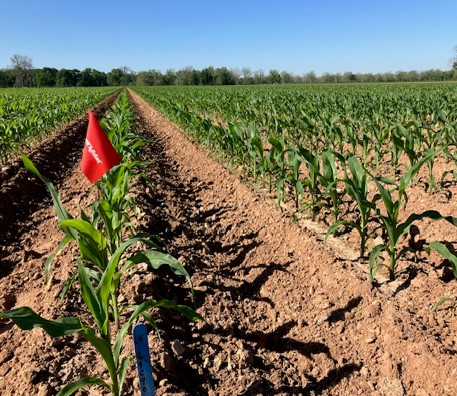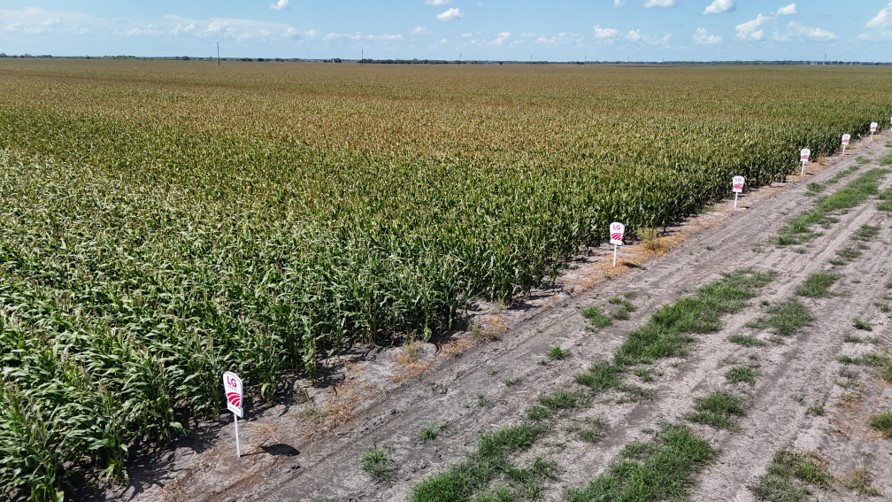AGRONOMICSUPPORT
YOU CAN TAKETO THE FIELD
A Hands-On Approach to Field Evaluations Benefits Farmers
“Test plots help me evaluate new hybrids and compare them to mature ones,” says LG Seeds Agronomist Jorge Guzman. That evaluation of hybrids also aids farmers, which is why he values this hands-on training.
Farmer involvement helps put the farmer and agronomist on the same page. “Farmers aren’t waiting for an agronomist to recommend a hybrid,” Guzman says. “Come decision time, they already have hands-on experience with how hybrids look and perform in their growing area.”
Key points
- Test plots are used to evaluate the performance of existing and new corn hybrids.
- LG Seeds agronomists perform seeding rates trials to optimize performance.
- Data from test points is used to improve hybrid scoring.
Thorough evaluation process
Guzman spends countless hours in test plots. “Before the season is over, I know what the front, middle and far end of the field looks like,” he says.
Guzman checks each test plot at least twice a month and picks up scouting intensity around pollination. He recommends weekly checks during this critical reproductive period when disease or pest pressure can take a major toll.

“Every time I’m out in farmers’ fields, I invite them to join me,” Guzman says. “At the very least, I give them a report on what I saw.”
Early-season field evaluations
The first thing Guzman evaluates is emergence. “I’m checking to see if corn plants are coming up strong, healthy and uniform,” he says, noting uniformity is the most important factor. “I want all the seeds coming up evenly throughout the field.”
V7 through pollination
As corn plants move into the V7 to V9 stages of growth, Guzman looks for uniform growth and plant health.
This is also when he invites farmers and dealers to test plots. “We want them to come and look at hybrids with us, so they know what we’re looking at and what to expect with the newer hybrids,” Guzman says. “It’s a learning process for them and for me.”
From V7 through pollination, he’s also on watch for disease pressure or nutritional issues. “At V7 to V9, you’re still able to make adjustments,” he says, adding he assesses standability and hybrids’ ability to withstand strong winds without
snapping.
As pollination nears, Guzman assesses how much of the corn plant’s silk comes out evenly with the tassels and whether hybrids produce a lot of pollen.
Making corn yield estimates as black layer nears
After pollination, Guzman’s focus shifts to ear set and whether ears have fully pollinated. He counts the number of rows around and kernels per row and uses that data to estimate yield potential.
“At the end of the season, I’m looking at when these hybrids get to black layer, how long it took to get to that stage, and uniformity as to when that occurred,” Guzman says.
Yield trials inform product recommendations
Test plots are also where different seeding strategies are tested. For instance, LG Seeds varied seeding rates at several of the Texas test plots this year that Guzman oversees. “We don’t want to tell farmers to increase populations in response to weather without having the data to show it’s a good idea,” he says.
The trials have also shed light on hybrid nuances, such as the fact some of them do better when planted a little later. “They come out stronger with more heat on the soil,” he explains.
The information Guzman collects from field evaluations provides feedback for AgReliant Genetics’ breeding program, which breeds one-of-a-kind genetics that LG Seeds offers to farmers. It also improves hybrid scoring.
Be open to new hybrids
Guzman says the hybrids that perform well year after year are always in high demand, but he encourages farmers to include new hybrids in the planting mix to spread risk. “Our test plots demonstrate the consistency of new products,” he says. “Building this confidence in new hybrids is one reason test plots are so valuable.”
Ready to see some of LG Seeds’ new hybrids for yourself?
Reach out to your local LG Seeds agronomist to visit a test plot.





